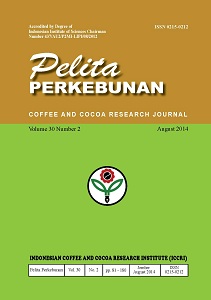Effectiveness of Bioinsecticide Bacillus thuringiensisFormulation Against Cocoa Pod Borer in Field Condition

Article Sidebar

PDF

Published
Aug 31, 2013
DIMENSION
ALTMETRIC
Main Article Content
Rein E Senewe
F.X Wagiman
Soekadar Wiryadiputra
Abstract
Field trial of Bt insecticide formulation with a code of formulation-A +1WP against cocoa pod borer (CPB) (Conopomorpha cramerella) has been conducted at the heavily infested cocoa area in Holo village, Amahai sub district, Central Maluku regency. Formulation-B 2.5 WP as a commercial Bt insecticide which has been distributed widely in the market was used as a comparison Bt insecticide. The results of the trial revealed that compared with untreated treatment, Bt insecticide formulation-A +1WP significantly reduced infestation of CPB, CPB population, and yield losses of dry cocoa bean caused by CPB. At the same concentration (2.5 g/L), the effectiveness of formulation-A +1WP was not significantly different with formulation-B 2.5WP. In the case of production increase, at the same concentration (2.5 g/L) formulation-A +1WP caused higher yield than formulation-B 2.5WP, i.e. 39.9% compared with 35.1%, respectively. Both Bt insecticide formulations tried did not caused phytotoxic against cocoa plant. It is recommended that controling of CPB should use concentration of 2.5 g/L Bt insecticide formulation/L of water, and should be applied at around early morning until 09.00 AM and / or at the afternoon after 15.00 PM. Spraying targets should be cocoa pods at the length of less than 8.0 cm which is not laid eggs of CPB yet. Key words: Cocoa, cocoa pod borer, Conopomorpha cramerella, control, effectiveness, microbial insecticide, Bacillus thuringiensis
Article Details
How to Cite
E Senewe, R., Wagiman, F., & Wiryadiputra, S. (2013). Effectiveness of Bioinsecticide Bacillus thuringiensisFormulation Against Cocoa Pod Borer in Field Condition. Pelita Perkebunan (a Coffee and Cocoa Research Journal), 29(2). https://doi.org/10.22302/iccri.jur.pelitaperkebunan.v29i2.58
Issue
Section
Articles

This work is licensed under a Creative Commons Attribution-NonCommercial 4.0 International License.
Authors who publish with this journal agree to the following terms:
- Authors retain copyright and grant the journal right of first publication with the work simultaneously licensed under a Creative Commons Attribution License that allows others to share the work with an acknowledgement of the work's authorship and initial publication in this journal.
- Authors are able to enter into separate, additional contractual arrangements for the non-exclusive distribution of the journal's published version of the work (e.g., post it to an institutional repository or publish it in a book), with an acknowledgement of its initial publication in this journal.
- Authors are permitted and encouraged to post their work online (e.g., in institutional repositories or on their website) prior to and during the submission process, as it can lead to productive exchanges, as well as earlier and greater citation of published work (See The Effect of Open Access).
